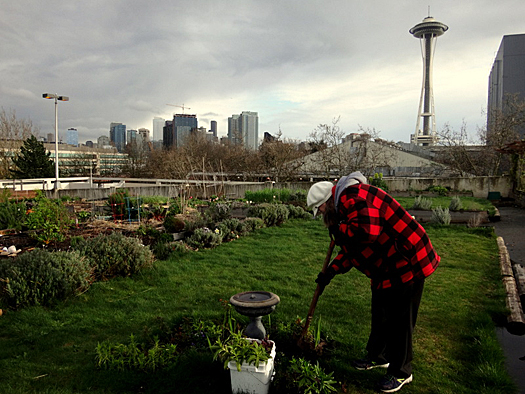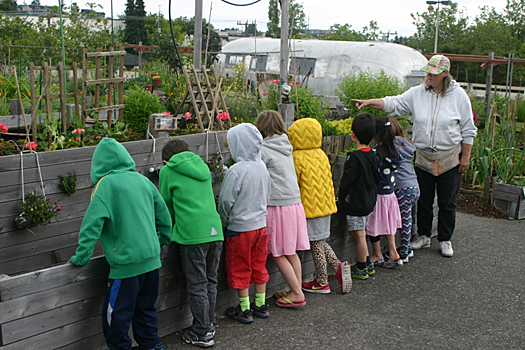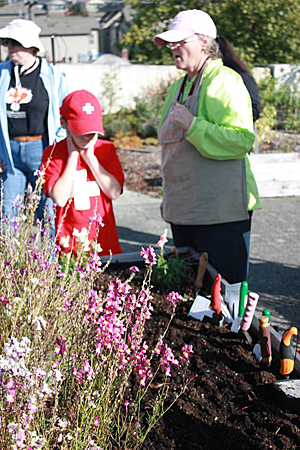Gardening Grandma Connects with Children

Her name is Bonnie Hedman, but she’s better known as the “Gardening Grandma.” If you’ve ever visited the UpGarden, the P-Patch community garden that sits atop the Seattle Center parking garage, you’ve probably seen her working in the common beds, or leading a children’s group through the “touch and smell” garden, or helping a new gardener get trained on how things work.
She’s the driving force behind the garden’s partnership with the Center School, the alternative high school located at the Seattle Center, which has its own student plot in the garden. She also manages the garden’s partnership with the nearby Brookdale Senior Living home, which grows the starts each year for the garden’s Giving Garden and the Children’s Garden. And she’s responsible for creating the “touch and smell” garden, which allows visually challenged students to experience the garden in a way they otherwise could not.
Each year, P-Patch gardeners are required to put in eight community service hours as part of the agreement to keep their plot. Last year, Bonnie logged 370 volunteer hours.
She took over leadership of the garden about a year ago, but she’s been involved in the garden since the planning stages. Said Bonnie, “I noticed a sign at QFC regarding the development of the garden, so I decided to go to a meeting. It was the group’s third one, and I’ve been involved ever since.”
Despite having a disability that prevented her from helping with labor, Bonnie took part in the construction of the garden in 2012. “I would fill my basket with screws, batteries, and water, and refill the crews’ supplies and make sure everyone was hydrated,” she said. “Once, I went home, made burritos and brought them back for lunch.”
Involving a local preschool
The original plans for the garden included a Children’s Garden, so Bonnie took it upon herself to reach out to schools, which led her to the Young Children Academy. She said, “We started by growing seeds and starts at the school, and then I would take them up to the garden and plant them. Once they planted mini-pumpkins, and when we harvested them, they got to decorate them.”
That connection led her to the Seattle School District, which was looking for a place to take visually impaired students. During a day camp, they developed the “touch and smell” garden, which includes plants such as pineapple sage, which smells like its namesake, and yarrow, which feels like a feather.
Looking for a way to get more people from the Seattle Center involved, Bonnie submitted a proposal to the Pacific Science Center to bring kids from the summer day camps up to the garden, which they’ve now been doing for three years. The Children’s Museum came on board last summer.
“I just try to keep my eyes open for opportunities to get different groups involved with the garden, especially when they’re right in the neighborhood,” Bonnie said.
A place for science experiments
The Seattle Center partnership led to a relationship with the Center School, whose students from two science classes now come to tend their plot at the garden. “The AP class does experiments, like which fertilizer works best,” said Bonnie. “It’s fun because sometimes they bring their families up to show off what they’ve been working on.”

Bonnie Hedman shows young students a raised bed that enables people with disabilities to garden at the UpGarden P-Patch. She made the flower-filled planters hanging on the wooden wall from old soda bottles.
In addition to educational outreach, Bonnie also manages the garden’s partnership with the Brookdale Senior Living home, located a couple blocks from the garden. Originally, another UpGarden gardener approached the senior home as part of a class assignment on community involvement, and the residents got involved by growing plant starts. Two of them now grow all the seedlings for both the Giving Garden and the Children’s Garden.
“I like to pick flowers from our common beds and make bouquets and take them over to the Brookdale residents,” Bonnie said.
Bonnie grew up as an Army brat who moved around a lot—but she remembers her family always growing food, no matter where they lived. As an adult, she lived in Montana with her two children, and home-grown food was an important part of their diet.
She’s been gardening ever since moving to Seattle with her kids in 1976, whether it was in a flower pot on an apartment patio or a shared garden at the Interbay P-Patch. She even managed to garden while living on a sailboat at Shilshole Bay Marina for seven years.
Why does she do it?
So why does someone volunteer hundreds of hours of their time to a community garden? One reason is that it can be tough to build a network of friends in a large city like Seattle.

Bonnie created a “touch and smell” garden that allows students with low vision to experience gardening more fully.
“I need people. And up there, we’re all gardeners. My community is so enlarged by the UpGarden,” Bonnie said. She thinks it’s also important to give back to the community. “I’ve always lived that way; it’s just part of who I am.”
One of the biggest benefits she gets from spending so much time at the garden is her physical well-being. “I’ve lost 40 pounds from walking back and forth from my apartment to the garden. And my bone density has gone up almost 9 percent,” Bonnie said.
More importantly, her mental well-being is also vastly improved. She said, “When I became disabled to the point I couldn’t work, I felt like I’d lost all value. I went from being an executive to living below the poverty line. But at the UpGarden, I can use my organizational and computer skills from when I worked.”
Despite all the benefits, Bonnie concedes she does have limits when it comes to how much she can do. She said, “It keeps me healthy to be up there, but I’ve learned I can’t overdo it. And there are certain tasks at the garden I’m not able to do.”
But anyone who knows her knows that disability doesn’t stop Bonnie from getting up to the garden nearly every day, rain or shine. She’s also become involved in the UpTown Alliance, a community development organization that is supportive of keeping the garden in the neighborhood when the Seattle Center parking garage comes down. (Those plans were always in the works, even before the garden was built.)
Bonnie said, “I’m learning about attending political meetings, and learning how to be an advocate for a cause—which is fun, because it’s not something I’ve done before!”
Bonnie expects she’ll log as many volunteer hours this year as the 370 she contributed in 2015 – if not more. And she wouldn’t have it any other way. “The garden pays me back every day in so many ways.”
Contributor Carolyn Kresser is an UpGarden P-Patch gardener. Her article originally appeared in the Spring 2016 issue of the P-Patch Post, which is published by GROW—a nonprofit advocacy organization for community gardens. It is republished with their permission.
![AgeWise King County [logo]](https://www.agewisekingcounty.org/wp-content/themes/agewisekingcounty/images/logo.png)